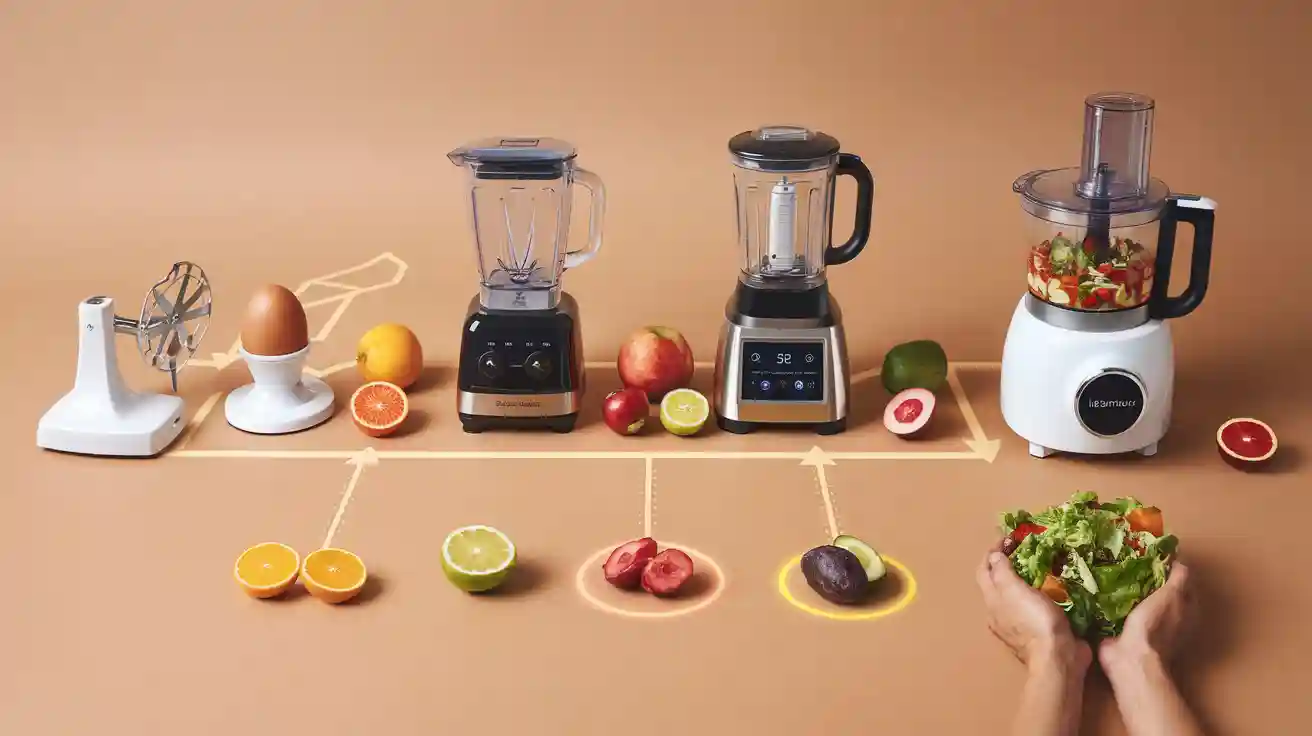
Modern kitchen innovation prioritizes nutrient preservation, supporting healthier lifestyles. Smart kitchen appliances, such as air fryers and steamers, meet rising demand for food prepared with less oil and better nutrient retention. Nutritionists note that proper cooking with these smart devices protects vitamins and antioxidants.
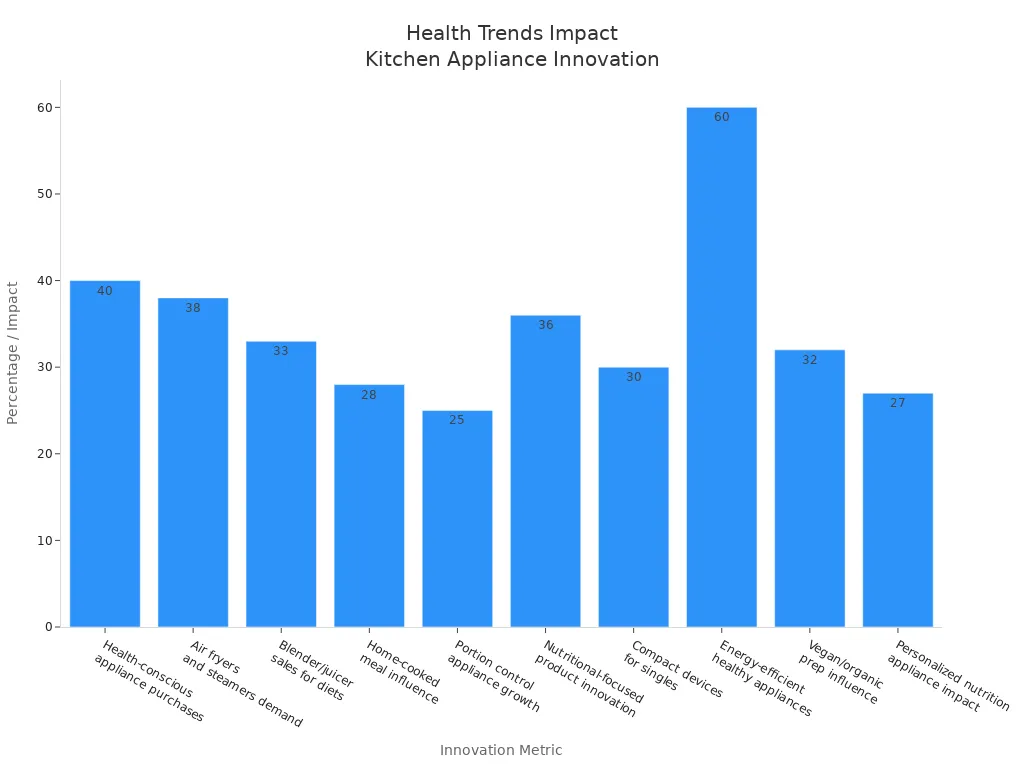
The Evolution of Kitchen Appliances
From Manual Tools to Early Electric Devices
Early kitchens relied on simple tools made from stone, bone, and wood. People used these tools to prepare food over open fires or in clay ovens. As time passed, metalworking skills improved. Cooks began using copper, brass, and bronze cookware, which lasted longer and handled heat better. During the Middle Ages, enclosed ovens and spit roasts became common. These changes allowed cooks to control temperature and try new cooking methods.
The Industrial Revolution brought big changes to the kitchen. Factories produced new kitchen appliance designs. Electric mixers, blenders, and food processors appeared, making food preparation faster and easier. By the 1940s and 1950s, electric stoves, ovens, and dishwashers became household staples. Stainless steel and enamel coatings made appliances safer and easier to clean. Later, digital controls and sensors improved precision and automation. Today, modern cooking appliances often connect to the internet and offer remote monitoring, showing the latest emerging trends in cooking appliances.
Tip: The shift from manual tools to electric devices reduced the time and effort needed for cooking, making it easier for families to prepare healthy meals.
The Gas Stove Revolution and Increased Efficiency
Gas stoves first appeared in the early 1800s and became popular in cities with gas pipelines. These stoves gave cooks instant heat and precise temperature control. This helped with delicate cooking techniques like sautéing and simmering. Gas stoves also made kitchens safer and easier to clean, thanks to features like enamel finishes and flame failure devices.
The introduction of gas stoves replaced open-hearth and wood-burning methods. Chefs could now cook food faster and more safely. In commercial kitchens, this meant better efficiency and more consistent results. Gas stoves also used energy more efficiently than earlier methods, helping families save time and resources. As technology advanced, gas stoves paved the way for even more efficient kitchen appliance designs, including induction cooktops and smart controls.
Technological Milestones in Kitchen Appliance Development
Refrigerators and Ovens: Expanding Food Safety and Cooking Options
Refrigerators and ovens changed the way people store and prepare food. Refrigerators keep food at safe temperatures below 40 °F, which stops harmful bacteria like Salmonella and Listeria from growing. Many families do not check refrigerator temperatures often, and overcrowding can cause cross-contamination. Studies show that only about 25% of people regularly monitor their refrigerator temperature. Ovens allow cooks to reach high temperatures that kill pathogens, making food safer to eat. Kitchen design also matters. Placing the refrigerator, stove, and sink close together helps people handle food safely and reduces the risk of illness.
Note: A well-organized kitchen layout supports hygienic food handling and improves food safety.
Industry experts highlight several milestones in kitchen appliance development:
- Steam-powered machinery like rotisseries and steam kettles changed cooking techniques.
- Electric ovens, grills, and mixers improved precision and efficiency.
- Stainless steel and non-stick coatings made appliances more durable and hygienic.
- Sous vide machines and smart ovens enabled precise temperature control.
- Kitchen automation and smart management systems optimized workflow.
- Energy-efficient appliances and eco-friendly materials support sustainability.
- IoT integration allows remote monitoring and predictive maintenance.
- Modular and customizable equipment meets chefs’ needs.
- Equipment for specialized diets and food safety supports health and wellness.
The Microwave and Small Appliance Boom
The microwave oven transformed household cooking in the late 20th century. By 1993, over 80% of American homes owned a microwave. This change led to new food products, such as microwavable popcorn, which became very popular. Since 2000, microwave sales have dropped, while sales of other small kitchen appliances like toaster ovens and air fryers have increased. People now prefer freshness and quality over speed. In Japan, small kitchens led to the use of microwaves combined with convection ovens. Cooking courses teach recipes that use microwaves for convenience and cleanliness.
Small appliances like the food processor and air fryer help families prepare food quickly and easily. The food processor chops, mixes, and blends ingredients, saving time. The air fryer offers a healthier way to fry food with less oil. Multi-function appliances combine several cooking methods, making modern cooking appliances more versatile. These technological cooking advancements make cooking easier and safer for everyone.
Smart Kitchen Innovations for Healthier Cooking
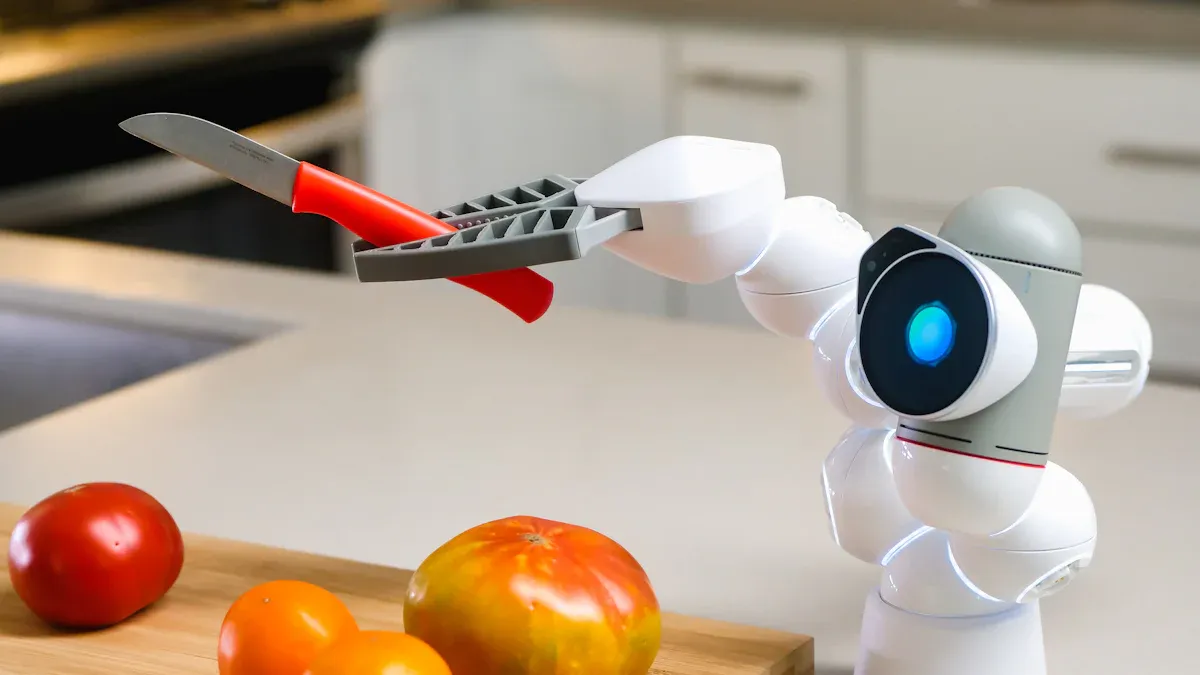
Precision Cooking and Nutrient Retention
Smart kitchen appliances have changed the way people cook and eat. Precision cooking uses advanced technology to control temperature and time. This helps keep more nutrients in food. Smart ovens and sous-vide machines use sensors and digital controls to avoid overheating and overcooking. These features help families prepare healthier meals.
- Sous-vide cooking keeps vitamins, minerals, and antioxidants in vegetables like carrots, parsley, and broccoli. Studies show that sous-vide preserves more nutrients than boiling or steaming.
- Smart ovens use precise temperature control and special cooking modes. These settings prevent nutrient loss and keep food safe to eat.
- Microwave ovens with advanced sensors cook food quickly and evenly. This method keeps more vitamin C in broccoli and other vegetables. It also helps keep protein quality high.
- Smart kitchen appliances like air fryers use less oil. This reduces fat in meals while keeping flavor and texture.
A table below shows how different smart appliances help preserve nutrients:
| Appliance Type | Key Features | Contribution to Nutrient Preservation |
|---|---|---|
| Smart Ovens | Precise temperature control, cooking modes | Avoid nutrient loss by preventing overheating and overcooking |
| Smart Stovetops/Ranges | Induction cooking, temperature tweaks, remote control | Precise temperature management reduces nutrient degradation |
| Smart Refrigerators | Inventory management, temperature customization, alerts | Maintain ingredient freshness, reduce spoilage and nutrient loss |
| Smart Indoor Gardens | Environmental controls (temperature, humidity, light), nutrient monitoring | Ensure optimal growth conditions for nutrient-rich plants |
| Smart Scales | Bluetooth/app connectivity, portion tracking | Accurate ingredient measurement supports nutritional balance |
| Smart Thermometers | Accurate cooking temperature monitoring | Ensures food is cooked properly, preserving nutrients |
Tip: Using guided recipes on smart ovens or air fryers helps home cooks follow the best steps for nutrient retention.
Smart kitchen appliances make it easier to cook healthy food at home. They help people save time and keep meals nutritious.
Automation and User-Friendly Features
Automation in the kitchen brings convenience and better results. Smart kitchen appliances use sensors, timers, and AI to guide users through each step. These features help people cook food safely and keep more nutrients.
- AI-driven guided recipes suggest healthy meals and adjust cooking settings for each dish.
- Smart ovens and air fryers use preset programs. These programs control temperature and time, making sure food cooks evenly.
- Smart thermometers send real-time updates to phones. This helps users avoid undercooking or overcooking meat.
- Multi-function appliances combine several cooking methods. This gives families more options and saves space in the kitchen.
- Smart refrigerators track food inventory and suggest recipes. This helps reduce waste and keeps ingredients fresh.
User surveys show that automation in smart kitchen appliances leads to healthier cooking. People report fewer mistakes and more consistent results. Guided recipes and meal planning features help users choose better meals. Smart scales and connected kitchens track ingredients and nutrition, making it easier to manage healthy eating goals.
Note: Automation and user-friendly features in smart kitchen appliances give families more time for other activities. This convenience supports healthier habits and better meal planning.
Smart kitchen innovations continue to improve. They help people cook healthy food with less effort. These tools make kitchens safer, more efficient, and more enjoyable for everyone.
Energy Efficiency and Sustainability in Modern Kitchen Appliances
Eco-Friendly Designs and Reduced Resource Consumption
Modern kitchen appliances now feature eco-friendly designs that help families save energy and resources. Manufacturers use advanced materials and smart engineering to make appliances that last longer and use less power. For example, Energy Star certified refrigerators use about 35% less energy than older models. Modern dishwashers use half the water and energy compared to those made 20 years ago. Induction ranges and convection ovens also use less power than traditional options.
| Appliance Type | Energy Efficiency Improvement / Statistic | Source / Notes |
|---|---|---|
| Refrigerators | Old models use about 35% more energy than Energy Star certified models | U.S. Department of Energy |
| Dishwashers | Modern dishwashers use about half the water and energy compared to models 20 years ago | Energy Star, Consumer Reports |
| Induction Ranges | Use about 15% less power than electric coil ranges | Energy Star, Consumer Reports |
| Convection Ovens | Use about 20% less energy than standard ovens | Consumer Reports, Constellation guide |
| Microwaves | Use approximately 80% less energy than electric ranges or ovens | Florida Power & Light, Consumer Reports |
| Countertop Appliances | Generally use less energy than ovens or stovetops; examples include air fryers, multi-cookers, slow cookers | Consumer Reports |
| Energy Savings | Replacing old refrigerators with Energy Star models can save over $160 and reduce carbon footprint by 4,000 pounds CO2 over lifetime | Energy Star 2024 Refrigerator Partner Toolkit |
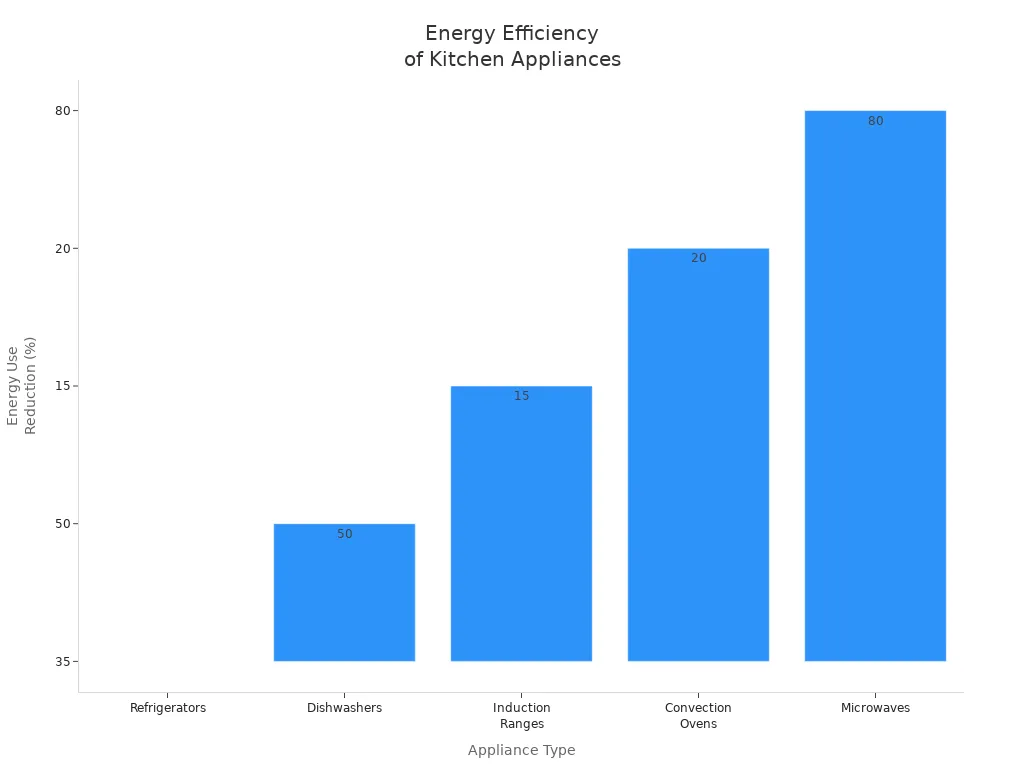
Lifecycle studies in Europe show that eco-innovations and changes in consumer habits can cut global warming potential by up to 35% by 2030. Using energy-efficient appliances and sustainable cookware helps lower emissions and waste. These choices support sustainable living and lead to lower utility bills over time.
Tip: Even small upgrades, like switching to an Energy Star refrigerator, can make a big difference for both the environment and your wallet.
The Role of Smart Technology in Sustainable Cooking
Smart technology helps families cook in ways that protect the planet. Devices with sensors and real-time data can adjust energy use, track food freshness, and prevent overcooking. These features lead to reduced food waste and lower energy bills. Smart refrigerators, ovens, and dishwashers use AI and IoT to monitor usage and suggest ways to save resources.
Environmental research shows that smart technologies like AI and cloud computing improve resource efficiency and supply chain transparency. These tools help farmers use less water and fertilizer, and they help families waste less food. Smart kitchen appliances also support sustainability by connecting to composting systems and using recycled materials.
- Smart appliances reduce energy and water use.
- They help track food inventory and prevent spoilage.
- IoT and AI allow devices to learn and adapt, making kitchens more efficient.
Sustainability organizations report that these innovations help lower greenhouse gas emissions and support energy efficiency and sustainability goals for homes and communities.
ESIUO’s Impact on Nutrient Preservation and Healthy Cooking
Advanced Technologies for Nutrient Retention
ESIUO uses advanced technologies to help families keep more nutrients in their meals. The ESIUO Digital Multicooker uses pressure cooking and microwave pressure cooking. These methods cook food quickly and seal in moisture. Laboratory studies show that these techniques keep more vitamins and healthy plant compounds in vegetables like broccoli. For example, pressure cooking keeps about 92% of Vitamin C and 83% of Sulforaphane. Microwave pressure cooking keeps nearly all Vitamin C and 97% of Sulforaphane. In comparison, boiling and steaming lose much more of these nutrients.
| Cooking Method | Vitamin C Retention (%) | Sulforaphane Retention (%) |
|---|---|---|
| Boiling | ~66 | 0 |
| Steaming | ~78 | 0 |
| Pressure Cooking | ~92 | ~83 |
| Microwave Cooking | ~91 | ~61 |
| Microwave Pressure Cook | ~100 | ~97 |
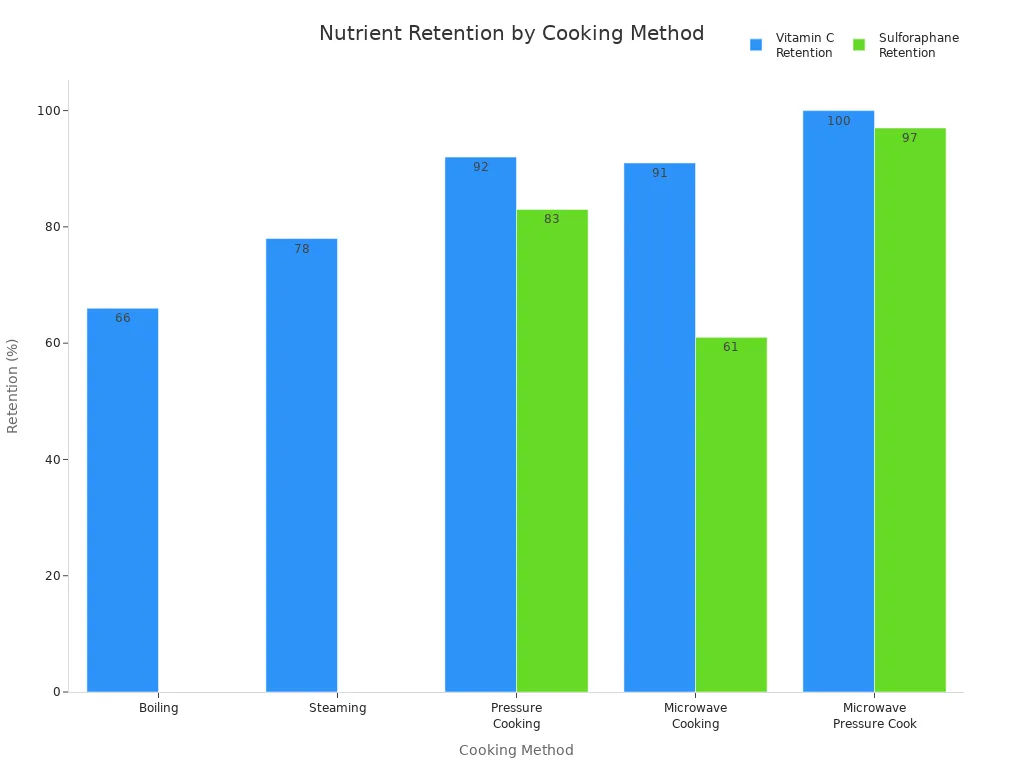
The multicooker also offers many presets, such as rice, yogurt, and steam. These options let users choose the best method for each type of food. App integration gives precise control, which helps keep nutrients locked in. The steam function helps retain vitamins and minerals. The slow cook mode makes tender meals with less fat. These features make it easier for families to prepare healthy meals at home.
Tip: Using the right preset for each meal helps keep more nutrients in your food.
Smart Controls and Customizable Cooking Modes
ESIUO stands out in the smart kitchen market with its advanced controls and flexible cooking modes. The multicooker uses sensors to monitor temperature and moisture. It can adjust settings automatically to prevent overcooking. This helps keep more nutrients in the food and saves energy at the same time. The app allows users to control the cooker from anywhere, making connected kitchens more convenient.
A comparison with other brands shows ESIUO’s strengths:
| Feature/Aspect | ESIUO Advantage | Competitor Comparison (e.g., Zojirushi) |
|---|---|---|
| Smart Controls | Advanced sensors monitor temperature and moisture, auto-adjusting settings | Use MICOM technology, induction heating, and AI for precision |
| Customizable Cooking Modes | Multifunctional: steaming, slow cooking, baking, all controllable via app | Focus on precise temperature control and consistency |
| App Connectivity | Remote monitoring and program selection via app | Less emphasis on app-based control |
| Energy Efficiency | Modes reduce overcooking and power use | Not specifically highlighted |
| User Convenience | Preset programs, voice alerts, easy maintenance | Emphasis on cooking precision rather than multifunctionality |
| Nutritional Outcomes | No direct comparative data available; smart features reduce overcooking, potentially preserving nutrients better | Competitors focus on precision but no explicit nutritional comparison |
ESIUO’s smart controls and customizable modes make cooking easier and more reliable. Preset programs and voice alerts add to the convenience. The app lets users select guided recipes and monitor progress. This helps prevent mistakes and supports healthy eating habits.
Real-World Examples: ESIUO in Action
Many users share positive experiences with ESIUO products. They say the electric composter makes composting fast and simple. This encourages more people to recycle food scraps and reduce waste. The machine runs quietly, so families can use it any time without noise. Odor control keeps kitchens fresh, even when composting leftovers. The compost comes out dry and clean, perfect for feeding plants and creating a healthier home.
- One user noticed a big change after switching to ESIUO. Instead of throwing away scraps, the family now makes compost every day. This reduces waste and supports healthy cooking.
- The time-saving features help busy families keep up with composting. Meals become healthier, and the kitchen stays clean.
- Users appreciate the convenience of quick composting and easy maintenance.
Note: ESIUO’s smart kitchen solutions help families save time, reduce waste, and make healthy cooking part of daily life.
Kitchen appliances now help families cook healthier meals with less effort.
- Air fryers lower harmful substances and support oil-less cooking, making food safer.
- ESIUO’s smart multicookers combine many cooking methods, save time, and use less energy.
- AI-powered appliances suggest recipes and adjust settings for better flavor and nutrition.
- Future devices will track nutrients and offer personalized advice for healthy eating.
FAQ
What makes smart kitchen appliances better for nutrient preservation?
Smart appliances use sensors and precise controls. These features help keep more vitamins and minerals in food. They also prevent overcooking and nutrient loss.
How does ESIUO’s multicooker help families eat healthier?
ESIUO’s multicooker uses pressure and steam cooking. These methods keep more nutrients in food. The app gives easy control and helps users choose healthy presets.
Are energy-efficient kitchen appliances worth the investment?
Energy-efficient appliances save money on utility bills. They also use less power and water. Many families see lower costs and help protect the environment.
Tip: Choosing Energy Star appliances can reduce both energy use and carbon footprint.


